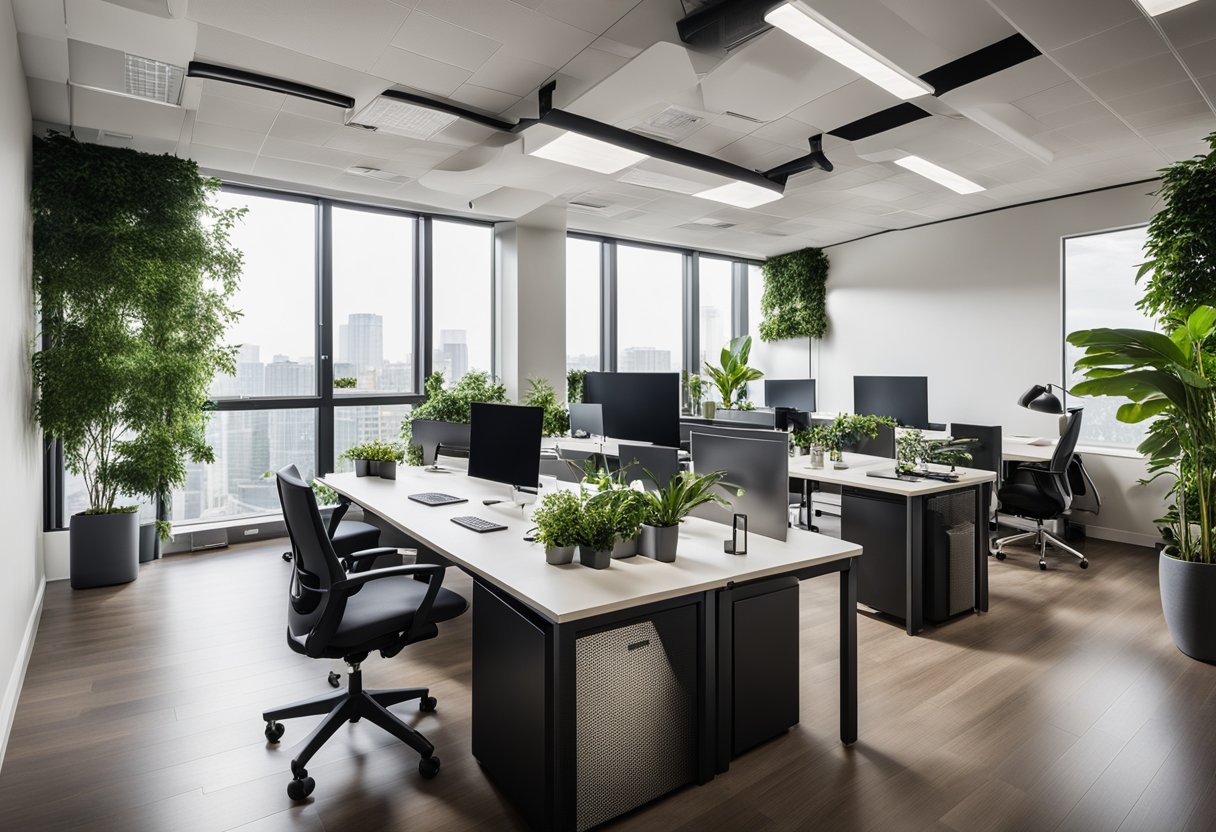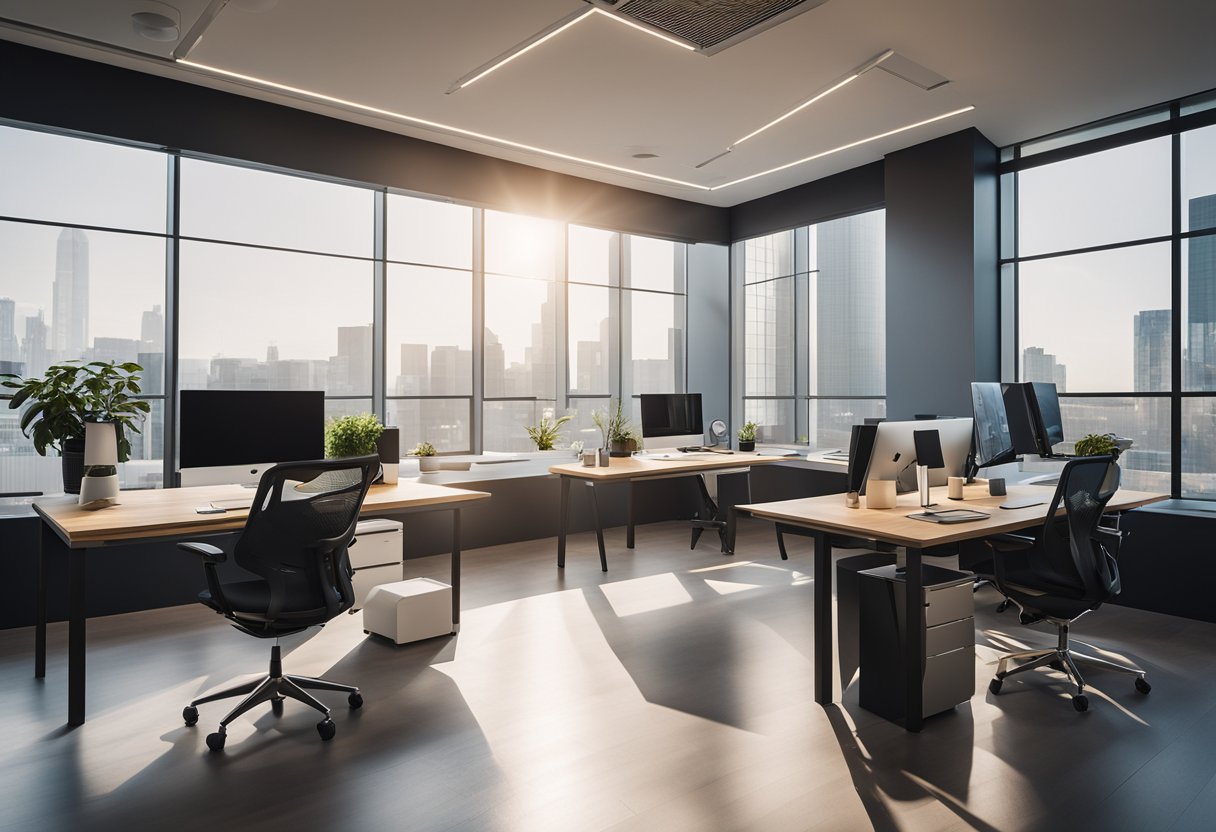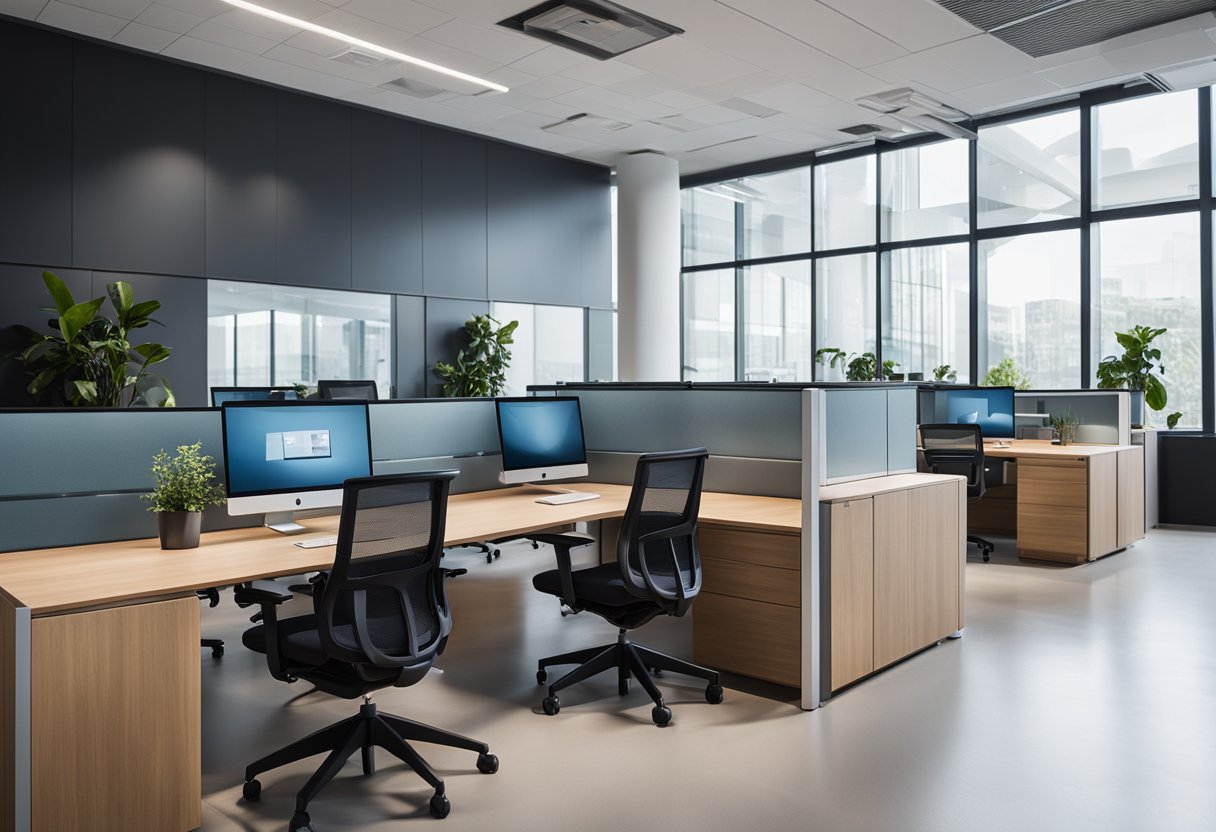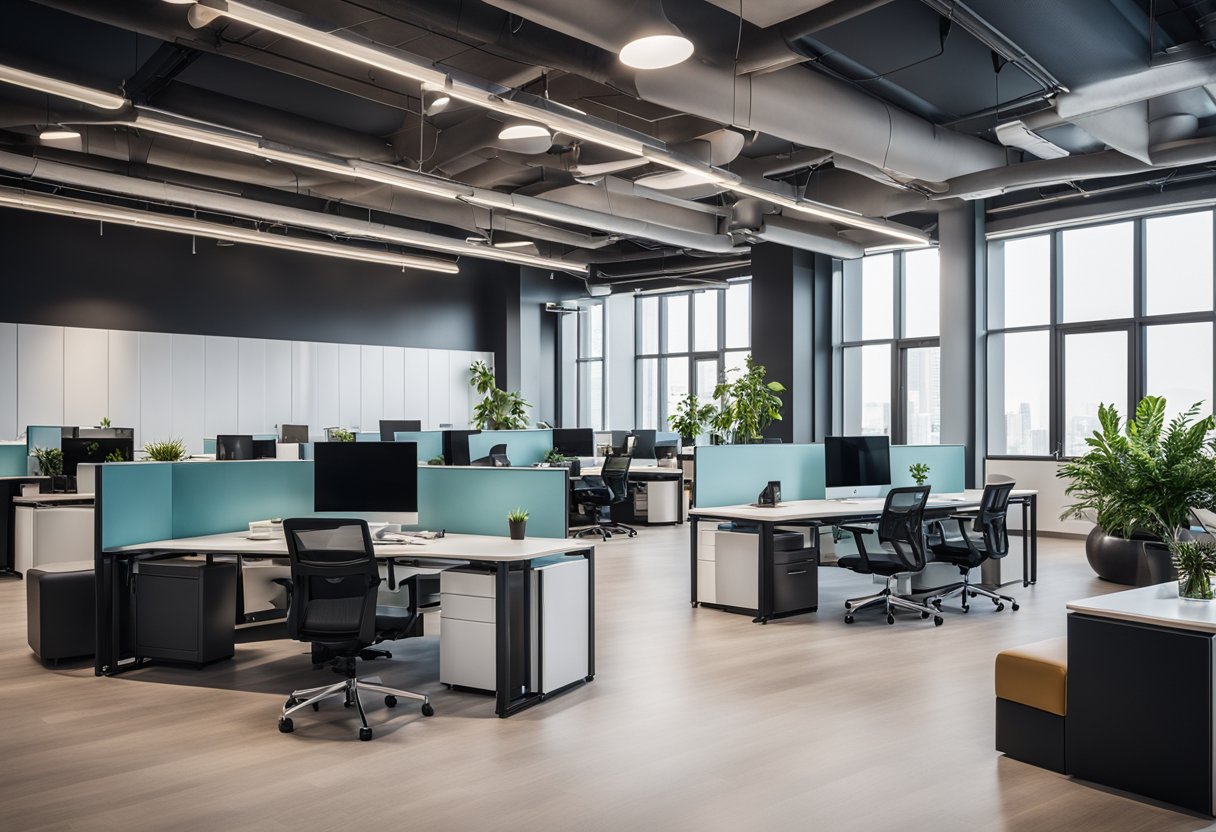Commercial Office Design Ideas: Boosting Productivity and Creativity in the Workplace
Are you looking to create a commercial office space that is both functional and visually appealing? Whether you are starting from scratch or revamping an existing workspace, there are a variety of innovative design elements that can help you achieve your goals. From ergonomic furniture to sustainable materials, the possibilities are endless when it comes to commercial office design.

One of the key factors to consider when designing a commercial office space is productivity. Your workspace should be designed in a way that promotes focus and minimizes distractions. This can be achieved through the use of sound-absorbing materials, comfortable seating, and ample natural light. Additionally, incorporating collaborative spaces can help to foster teamwork and creativity among your employees.
As technology continues to advance, the future of commercial office design is looking more exciting than ever. From virtual reality to smart lighting systems, there are a variety of cutting-edge technologies that can help to enhance the functionality and aesthetics of your workspace. By staying up-to-date with the latest trends in commercial office design, you can create a space that is both functional and visually stunning.
Key Takeaways
- Innovative design elements can help to create a functional and visually appealing commercial office space.
- Productivity is a key factor to consider when designing a workspace, and can be achieved through the use of sound-absorbing materials, comfortable seating, and ample natural light.
- Staying up-to-date with the latest trends in commercial office design can help you create a space that is both functional and visually stunning.
Innovative Design Elements for Modern Workspaces

As the world of work evolves, so does the design of modern workspaces. With the rise of hybrid and remote work models, office design trends are shifting towards creating dynamic and flexible spaces that foster innovation and collaboration. In this section, we will explore some of the innovative design elements that can be incorporated into modern workspaces to enhance productivity, employee well-being, and corporate culture.
Embracing Natural Elements and Biophilic Design
One of the most significant trends in office design is the incorporation of natural elements and biophilic design. Biophilic design involves bringing nature into the workplace, whether through the use of plants, natural light, or natural materials. Studies have shown that incorporating nature into the office can have a positive impact on employee well-being, productivity, and creativity. By incorporating natural elements, you can create a more relaxed and peaceful environment that promotes focus and concentration.
Strategic Use of Colour and Light
The strategic use of colour and light can also have a significant impact on the design of modern workspaces. Pops of colour can help to break up the monotony of the office environment and create a more vibrant and dynamic space. The colour palette can be used to reflect the corporate identity and create a cohesive and professional look. Lighting can also be used to create a more comfortable and inviting environment, with natural light being the most desirable.
Furniture and Layout for Enhanced Productivity
The furniture and layout of the workspace can also play a significant role in enhancing productivity and employee well-being. Flexible furniture, such as standing desks and ergonomic chairs, can help to reduce the negative impact of prolonged sitting on physical health. The layout of the workspace can also be designed to encourage collaboration and communication, with collaborative spaces and meeting rooms strategically placed throughout the office.
Integrating Technology for a Smarter Office
Digital technology has become an essential part of modern workspaces, with the integration of technology being a significant trend in office design. From video conferencing to smart lighting and heating systems, technology can be used to create a more efficient and productive workspace.
Creating Dynamic Social Spaces
Social spaces, such as bars, lounge areas, and meeting rooms, can be designed to create a more dynamic and engaging workspace. These spaces can be used for informal meetings, brainstorming sessions, or simply as a place to relax and socialise. By creating dynamic social spaces, you can foster a sense of community and collaboration within the workplace.
Balancing Privacy and Openness
Balancing privacy and openness is another crucial element of modern workspace design. While open offices can promote collaboration and communication, they can also be distracting and noisy. The use of partitions, acoustic panels, and pods can help to create a more private and focused work environment.
Design Details that Reflect Corporate Identity
Design details, such as custom graphics, wall coverings, and corporate lobby design, can be used to reflect the corporate identity and create a cohesive and professional look. By incorporating design details that reflect the corporate identity, you can create a workspace that is both functional and aesthetically pleasing.
Sustainable Practices and Materials
Sustainability is becoming an increasingly important consideration in modern workspace design. From the use of sustainable materials to the implementation of energy-efficient systems, there are many ways to create a more sustainable workspace. By incorporating sustainable practices and materials, you can create a workspace that is both environmentally friendly and cost-effective.
Adapting to a Changing Work Landscape
The rise of hybrid and remote work models has created a need for adaptable and flexible workspaces. By designing workspaces that can accommodate different working styles and preferences, you can create a more inclusive and supportive work environment.
Incorporating Leisure and Wellness
Incorporating leisure and wellness into the workspace can have a positive impact on employee well-being and productivity. From on-site gyms to meditation rooms and quiet zones, there are many ways to create a more holistic and supportive work environment.
Trends Influencing Office Design Globally
Office design trends are influenced by many factors, including cultural influences, urban space planning, and innovative sales techniques. By staying up to date with the latest office design trends globally, you can create a workspace that is both functional and aesthetically pleasing.
Fostering Innovation and Collaboration
Innovation and collaboration are essential elements of modern workspaces. By fostering a culture of innovation and collaboration, you can create a workspace that is both dynamic and engaging.
Elevating Aesthetics with Art and Accessories
Art and accessories can be used to elevate the aesthetics of the workspace and create a more engaging and inspiring environment. From minimalist designs to bold and colourful decorations, there are many ways to incorporate art and accessories into the workspace.
The Role of Office Design in Employee Productivity
Office design plays a significant role in employee productivity and well-being. By designing workspaces that are both functional and aesthetically pleasing, you can create a workspace that promotes focus,
The Future of Commercial Office Design

As the world transitions into a post-pandemic era, commercial office design is evolving to meet the needs of a changing workforce. Here are some of the trends that are shaping the future of office design:
Predicting Post-Pandemic Office Trends
The pandemic has accelerated the shift towards remote work, and many experts predict that hybrid work models will become the norm. This means that office design will need to be flexible, dynamic, and capable of accommodating a variety of work styles and preferences.
Innovations in Space Utilisation and Flexibility
In order to accommodate hybrid work models, commercial office design is moving away from traditional cubicles and closed-off spaces towards open floor plans and collaborative spaces. This allows for greater flexibility and encourages teamwork and innovation.
Advancements in Environmental Sustainability
Sustainability is becoming an increasingly important consideration in commercial office design. From green roofs and living walls to energy-efficient lighting and HVAC systems, designers are finding innovative ways to reduce the environmental impact of office buildings.
The Evolution of Coworking and Shared Spaces
Coworking spaces and shared workspaces are becoming more popular as workers seek out flexible and collaborative work environments. These spaces are designed to foster creativity, innovation, and community, and are often equipped with state-of-the-art technology and amenities.
The Impact of Digitalisation on Workplace Design
Digital technology is transforming the way we work, and commercial office design is no exception. From smart lighting and temperature control systems to virtual reality meeting rooms, designers are finding new ways to incorporate technology into the workplace to enhance the employee experience.
Embracing the Connection Between Design and Well-Being
The importance of employee well-being is becoming increasingly recognised in commercial office design. Biophilic design, which incorporates elements of the natural world into office spaces, is gaining popularity as a way to promote physical health, reduce stress, and improve productivity.
Overall, the future of commercial office design is exciting and dynamic, with a focus on flexibility, sustainability, and employee well-being. As the workplace continues to evolve, designers are finding innovative ways to create spaces that are both functional and inspiring.
Frequently Asked Questions

How can you revitalise a small office space with innovative design?
Revitalising a small office space with innovative design can be a challenge, but there are several strategies you can use to make the most of your space. One approach is to use modular furniture that can be easily reconfigured to suit different needs. Another strategy is to incorporate natural light and greenery, which can help to create a more inviting and energising atmosphere. Using bold colours and patterns can also add interest and personality to a small space.
What are the latest trends in crafting modern, dynamic office layouts?
Modern, dynamic office layouts are all about flexibility and collaboration. One of the latest trends is to create spaces that can be easily adapted for different uses, such as open-plan work areas that can be transformed into meeting rooms or breakout spaces. Another trend is to incorporate technology, such as wireless charging stations and smart lighting, to make the workspace more efficient and user-friendly.
How can you achieve a stylish commercial office interior on a tight budget?
Achieving a stylish commercial office interior on a tight budget requires creativity and resourcefulness. One approach is to use inexpensive materials, such as plywood or industrial piping, to create a unique and modern look. Another strategy is to repurpose existing furniture or decor items, such as using old wooden pallets as wall art or incorporating vintage pieces into the design. Finally, consider DIY projects, such as painting walls or creating your own artwork, to add personality and style to the space.
What are the essential principles to follow when designing a corporate office?
When designing a corporate office, it is important to consider the needs of the employees and the company as a whole. Essential principles include creating a functional and efficient workspace, incorporating branding and company culture into the design, and promoting a healthy and productive work environment. It is also important to consider factors such as lighting, acoustics, and ergonomics to ensure that the space is comfortable and conducive to work.
What creative strategies can be employed to enhance office wall aesthetics?
Enhancing office wall aesthetics can be achieved through a variety of creative strategies. One approach is to use wallpaper or wall decals to add interest and texture to the walls. Another strategy is to create a gallery wall of artwork or photographs to showcase the company’s culture or values. Finally, consider incorporating functional elements, such as whiteboards or chalkboards, into the design to add both style and practicality to the space.
How do you balance functionality and style in office design for limited spaces?
Balancing functionality and style in office design for limited spaces requires careful consideration of both form and function. One approach is to use multifunctional furniture, such as desks with built-in storage or seating, to maximise the use of space. Another strategy is to incorporate open shelving or wall-mounted storage to keep clutter off the floor and create a more streamlined look. Finally, consider using a neutral colour palette and simple, clean lines to create a cohesive and uncluttered design.



